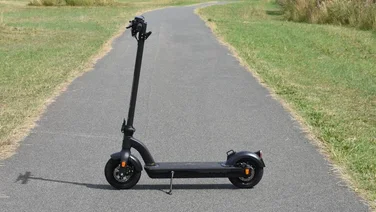To help us provide you with free impartial advice, we may earn a commission if you buy through links on our site. Learn more










Compact system cameras (CSCs) are still toddlers compared to their mature SLR brethren, yet Panasonic’s GF range is already starting to feel like a familiar friend. The GF5 is the fourth incarnation, but differences to last year’s Panasonic Lumix DMC-GF3 are relatively minor. The screen resolution is up from 460,000 to 920,000 dots. The handgrip is more substantial and its textured rubber design is easier to hold. The buttons are made of metal rather than plastic and there’s an additional one marked Display for toggling onscreen information on and off. Additionally, the maximum ISO speed has doubled to 12,800, but the resolution remains 12 megapixels.

As before, most functions are accessed via the touchscreen. It’s one of the better systems we’ve seen, having a physical Quick Menu button that reveals five commonly used functions across the screen. These can be customised if they’re not the ones you want, and a second page of five functions can be added. The touchscreen makes it effortlessly quick to move the autofocus point. We’d have liked a physical mode dial, but we’re not sure where it would have fitted. The currently selected mode is shown in the top-left of the screen, and pressing it turns the wheel on the back of the camera into a mode dial.

The kit lens is remarkably slim but we’d prefer to have lens rings rather than levers for zoom and focus
The microphone is now stereo rather than mono, but its location isn’t ideal and we sometimes accidentally covered it with a finger while recording videos. The camera automatically turned the volume up to compensate and the resulting interference that it picked up sounded like the workings of a 1970s supercomputer.
Otherwise, this is a superb point-and-shoot video camera. The 1080p videos are extremely sharp and clean, even in low light, although the 16Mbit/s AVCHD files sometimes displayed compression artefacts in fast-moving clips. The lens’s zoom and focus motors are virtually silent, and the motorised zoom function arguably gives smoother results than a mechanical lens ring would.

The biggest change over the GF3 is the availability of a new kit lens that provides a 3x zoom function and collapses down to 31mm when not in use. The GF5 is unusually small and light for a CSC too, and together they’ll slip into most pockets. This is in keeping with the spirit of the GF series, providing SLR-like image quality in a small point-and-shoot package. It’s not a cheap lens, though. The GF5 is available with the older, bulkier version of the Panasonic 14-42mm lens for around £400, but it’s much more expensive with this Power Zoom lens. It’s also less satisfying to use than the bulkier lens, having levers rather than rings to control zoom and focus. Sony’s similar 16-50mm lens, recently unveiled alongside the Sony NEX-6, includes a single lens ring that timeshares between zoom and focus duties and is much more rewarding to use as a result.
Autofocus performance was extremely quick. This is one area where Panasonic still holds a comfortable lead over Sony’s NEX cameras. Rapid-fire shooting in the Single drive mode started enthusiastically, providing just 0.6 seconds between shots, but the camera couldn’t save them as fast is it captured them. After four frames, it slowed to 1.8 seconds between shots. Continuous shooting started at 4.1fps, but slowed to 2.1fps after 13 frames. That’s respectable, but the Sony NEX-F3 was a little faster.
CSCs usually excel for low noise thanks to their large sensors, but the GF5 is lagging behind the pack for noise performance. The Panasonic DMC-GX1 exhibited less noise, despite its higher resolution, and Sony’s NEX cameras exhibited far less.

Heavy noise reduction makes these indoor skin textures look like they’re out of focus – click to enlarge
This had obvious implications when shooting in low light, with a distinct lack of fine details at ISO 1600 and some ugly noise-reduction artefacts at ISO 3200 and above. However, it was impossible to escape the clutches of noise reduction, even in brightly lit scenes, with a smudged appearance to fine details even at the slowest ISO 160 setting. We have no qualms about the relatively modest 12-megapixel resolution of this sensor, but it really should be managing lower noise than this. Panasonic made the wrong decision by not including the GX1’s sensor here.

Noise can be an issue even in bright light, with noise-reduction processing glossing over details – note how much more shadow detail we were able to get from the raw file – click to enlarge
The GF5 is expensive, but comparisons with the Sony NEX-F3 are fairer when the GF5’s paired with its bulkier zoom lens. This puts both cameras on a level playing field for both size and price. Then again, the GF5’s compactness is, for us, its strongest attribute. With the bulkier lens, it fails to stand out. Those who want an entry-level CSC should go for the Sony NEX-F3, while those who simply want a high-quality, truly compact camera are better off with the excellent Panasonic Lumix DMC- LX7.





